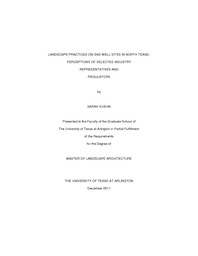| dc.description.abstract | Fossil fuel extraction, a principal industry in Texas, has turned toward natural gas exploration in the Barnett Shale, altering the landscapes of urban and rural communities alike. Improvements in technology have caused dramatic increases in the concentration of gas wells being drilled in large metropolitan areas, such as the Fort Worth area of North Texas. The result is an increase in awareness about urban drilling and its impact on regional environment (BSEEC 2011). In response, individual municipalities have amended their natural gas well ordinances and now mandate the implementation of regulations, such as permitting processes and the reclamation of sites, through the stages of drilling, production, and site abandonment (BSEEC 2011). As urban environments and these industrial processes merge, city departments, state and federal regulators, and industry members have developed practices to lessen nuisance impacts, impacts to environmental resources, and interference with existing businesses (GWPC 2009, p. ES-5).With increases in the production of natural gas comes the growing concerns of human health, environmental impact, and aesthetics, and as influences on the approval, permitting, and locating of gas wells within urban areas, these factors provide a vital role in the simultaneous development of minerals and protection of the health, safety, and welfare of the community (GWPC 2009). According to Drill-Right Texas, an oil and gas development best practices initiative, "the challenge facing us today is how to protect our landowner rights, clean water, air, and public health in the face of rapid energy development" (TOGAP 2010). This research studied the perceptions of selected industry representatives and regulators in relationship to site location, development, and remediation practices. With the use of in-depth interviews and open-ended questioning, participants were allowed to express their lives, experiences, or situations as expressed in their own words (Taylor and Bogdan 1998). The research concluded with a summary of findings, providing a more complete understanding of gas well remediation and reclamation processes in the urban environment and the developing role and demand for landscape architects.Through the assessment of themes regarding determinants for remediation efforts and priorities, community values have emerged as the primary factor among respondents' perceptions. Surrounding land uses are established as core identifiers of community values, and as a result city ordinances regulate interactions among neighboring land uses. The amount of remediation a site receives depends mainly on the surrounding land uses in a metropolitan area, with residential areas demanding the highest amount of screening of noise and aesthetic nuisances. The interview participants provide an insight into the lack of knowledge and awareness of how these gas well sites will affect the future landscape and habitats of urban environments. The selected industry representatives and regulators were focused on the current appearance and remediation of visual impacts, noise, dust, and traffic, with minimal focus on what these sites will actually look like in twenty years. However, through additional study and future research there may be more exploration and emphasis on the impact and integration of these gas well sites into the development of urban master plans of municipalities. | en_US |

